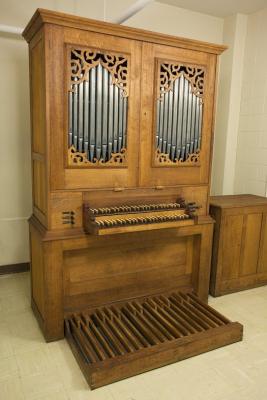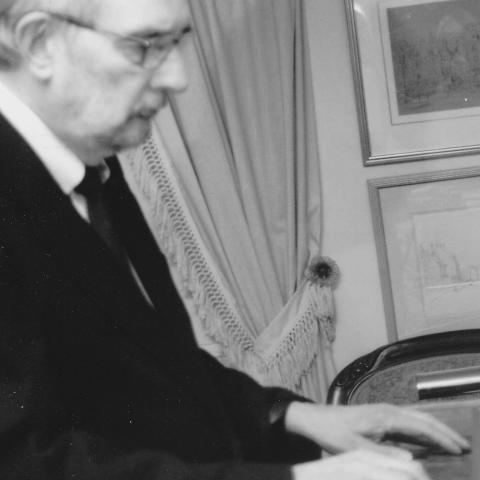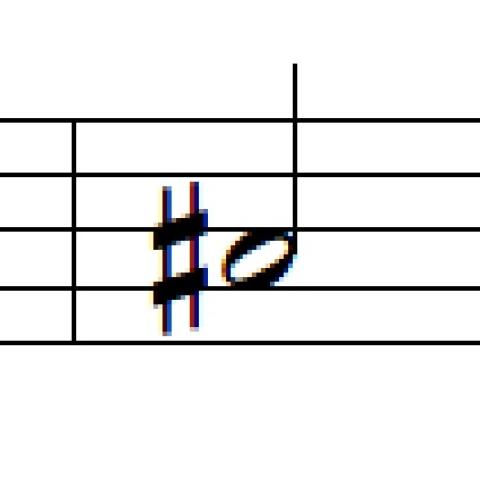
Westminster Choir College: memories and reflections
This column marks my return from a seven-month break—a sabbatical that I took to catch up on various things and to think about and plan for the future direction of this column. I return quite eager and feeling relaxed and energized.
During these seven months a lot has happened in the world—not surprisingly. But a few things that have occurred during my break are of particular interest to organists and of some relevance to this column. In early June, Rider University of New Jersey announced various cuts in programs. These cuts were university-wide, but they had a particular effect on Westminster Choir College since they included the elimination of the organ performance and sacred music degree programs. The organ department and its performance program constituted my professional home for many years, and even though I have not had much direct connection to Westminster for the last twenty years or so, this change feels momentous to me. It occasions most of the reflections in this column.
Also during these same months, two former longtime Westminster organ professors passed away: Robert Carwithen on May 11 and Donald McDonald on August 5 (see McDonald’s obituary in this issue). I did not study with either of them, but I knew them and would see each of them a few times most weeks for decades. I would not be the right person to write a thorough tribute to either of them. But I want to mention here that I got a lot of joy from knowing each of them and had deep respect and admiration for their knowledge and insight, as well as their kindness to me as a student and later as a young colleague.
I should mention that I do not intend to analyze or discuss the whole arc of the changes that have taken place with respect to Westminster Choir College over the last several years, which are massive in nature and extent. I share the visceral sadness that many friends and colleagues experience at the thought of the Westminster campus in Princeton vacant and void of college life. This sadness is especially vivid and present for me since the Princeton Early Keyboard Center studio is across the street from that campus, and I see it most days. I am not privy to much real information about what has been going on at Westminster, and I have no idea how things will evolve going forward. Nonetheless, I have used the announced end of the Westminster organ program as an occasion for me to look back on some of what that program meant to me over the many years when I was closely and deeply involved with that program as a visitor, student, and teacher.
In a recent column I described how my then-teacher Paul Jordan helped me find a new teacher in Princeton as I was about to head off to college from my home in New Haven, Connecticut. He did so by speaking to Helen Kemp of the Westminster faculty, whom he knew and had worked with. As far as I recall, this was the first time I had heard of Westminster Choir College. What I get from this memory now is a reminder that I was somewhat insular in my approach those days. I am pretty certain I had never heard of Gustav Leonhardt or Virgil Fox, to name two examples from different corners of the world that I hoped to inhabit. The performers whom I happened to encounter I delved into deeply—Helmut Walcha, E. Power Biggs, Marcel Dupré—but my overall approach was one of an innocent lack of curiosity. I believe that it is also at least tangentially related to something that is probably a strength, a well-developed lack of interest in being buffeted about by fashion or influence. That youthful lack of curiosity (or laziness about looking into things and expanding horizons) might be related to my insistence on working things out for myself. This is something I believe in very strongly and commend urgently to students.
As I have also recounted elsewhere, I started studying privately with Eugene Roan shortly after I started at Princeton University. We had our lessons at the university chapel, so the first time that I set foot on the Westminster campus was at a recital that Professor Roan gave in the fall of 1974 on the Casavant organ in the basement of Dayton Hall. That building was a dormitory above ground, but below the surface was the central venue of the organ department. The recital hall was at one end, and along various corridors were faculty offices and practice rooms. One thing that I get now out of remembering that first visit is an awareness of how long that space indeed stayed much the same. I am fairly sure that the offices housed mostly the same faculty members, and the practice rooms the same organs, for about twenty years after that day.
But the Westminster organ department was a place. I care a lot about the sense of place.
The place that was the Westminster organ department was labyrinthine. The basement that I mentioned was the hub. But corridors connected that space to other basement spaces where there were also practice organs. There was even an organ in a small room that was located in a corridor between buildings. The web extended to other buildings—a couple of other dormitories, nearby though not connected, where there were practice rooms; the chapel building, where there was an organ in the upstairs chapel space itself, and other organs in smaller rooms on the ground floor level, and, if I remember correctly, a closet for the organ maintenance department. This is the kind of interconnected and spread-out space that I love.
With so many practice rooms and students, faculty members, and visitors, one had to expect practicing to be overheard as a matter of course. During the time when I was a student at Westminster in the 1980s this sense of being overheard helped me to overcome or at least to manage performance anxiety and a general kind of shyness about playing and about artistic expression. These are indeed two separate things. There is the stage fright sort of anxiety, the fear of making mistakes, even falling apart, or of being judged a “bad” player by someone who hears you play. I had been consumed by that fear at least all the way through high school and well into my college years. I got a great deal of help in this department from Professor Roan in lessons and discussion, and from simply making myself perform. I also got a lot out of the particular Westminster approach to teaching performance, which I wrote about in these terms in February 2018 issue:
With pieces that we were working on there were levels of performing that were pretty carefully stepped up. First there were two informal ones: the awareness that everything that went on in any practice room could be heard pretty easily by anyone who walked by, and the customary practice of students playing informally for their friends. The next step was studio class, where the atmosphere was relaxed, where all of the other people in the room were in exactly the same boat, and where you could play a given piece more than once as the weeks went by and get more comfortable with it. Then some pieces would be brought to performance class, the same sort of thing, but department-wide, with the ever-present possibility that some people from outside the department might be there. Then on to various recitals . . . .
This starts with the awareness of being overheard. That awareness also exists to be ignored—doing so is good concentration practice.
The practice organs at Westminster exhibited a great deal of variety. The two very small two-manual Flentrops were the instruments that interested me the most. They were of the same design—upper manual featured only a 4′ flute, the lower manual consisted of 8′ + 2′, the pedal consisted of a lone 8′, and there were the usual couplers—but sounded and felt a bit different. Those of us who focused on these instruments tended to have one of them that was our favorite. They both had an extremely sensitive action along with flexible (or what some would call “unsteady”) winding. The action was sensitive in that the shape and nature of the attacks and releases varied a lot with different sorts of touch. Each of these organs could sound like a different instrument based on the minutiae of how they were being played.
A certain small Noack practice organ in a nearby room also had a very sensitive action, but in a different way: the action was light enough that it was painfully easy to make notes sound by barely brushing up against them from the side. This made it an ideal instrument for drilling notes and in general for developing accuracy and straightforwardly clean playing habits. I should probably have spent more time than I did in that room.
The Flentrops, however, had the shortest pedal sharps that I have ever encountered. That, combined with the sensitive wind supply, made them really intense training tools for pedal accuracy, in particular for those who wanted to play on flat pedalboards. The presence of a variety of pedalboards—flat, American Guild of Organists standard, other sorts of concave and/or radiating with various levels of sensitivity—helped train me not to care very much about pedal differences. Sometime in the course of my student days I realized that I could go back and forth among pedal keyboards as different as they come without any trouble. This led to some of the specifics of my approach to teaching pedal playing, in particular conceiving of the physical act of pushing down pedal keys as being a point rather than a line.
In addition to being a place, the Westminster organ department was also a community. Everyone who was a member of that community had their own feelings about it at the time and subsequently has their own memories of it. I have no sense that mine are the same as others. I also know that school is difficult, and that students and faculty members can experience tensions arising out of overwork, competitiveness, envy or jealousy, fear about career prospects, and so on. However, my own experience of the department as a community when I was a student and later as a faculty member was that it was relaxed, friendly, nurturing, conducive of cooperation rather than conflict, and in general a social and academic environment in which I could thrive. I do not mean this as boilerplate, but rather as something quite specific. As I have written before from time to time, I was a “late bloomer” as a practical musician. I was deeply interested in music from a very early age, but it took me ages to develop the focus and discipline to practice particularly well or indeed very much at all. When I was ready to go to college, I was not a developed enough player to consider applying to music schools. During my undergraduate years at Princeton I spent a lot of time and mental effort on remedying this with help from Professor Roan via the private lessons that I took with him. When in due course I was ready to apply to graduate school, I had reached a stage where I could play some music very well. But I was not anything like a polished virtuoso as I had a small repertoire and was an atrocious sight reader. I was subject to lapses in concentration that made it pretty much hit-or-miss whether I would play anything like my best any given time. The atmosphere of graduate school could easily have been crushing to my spirit. Among the older musicians I knew there were several who advised me not to put myself into that kind of situation. At Westminster I found a kind of infectious joy in whatever each member of the community could do well, a sense that not everyone had to be good at or even involved with the same things, and an awareness that there is plenty of time to learn whatever you still need to learn. This was exactly what I needed to thrive at that point in my life, rather than wither away or shrivel up. These ideas form one of the cores of my own approach to teaching.
I picked up a lot of “little random stuff” while at Westminster. I know that there are many pieces that I first became interested in because I walked by a room in which someone was practicing something that was unfamiliar to me and that intrigued me. I believe that I became interested in Messiaen that way. There was a time when a fellow student whom I did not particularly know opened the door of his practice room as I was passing by and asked if I would come in and listen to him play the Buxtehude Praeludium in D Major and give him my feedback. I did not know why at the time—I probably filled in the “why” with the assumption that he thought that I was a great Buxtehude expert. Just as likely he just wanted to practice playing under the pressure of someone’s listening. Maybe he was asking for feedback just to be polite. This was a significantly more skilled (advanced) player than I was at that point, so I was rather stunned that he wanted my help. It was a small thing, but it actually contributed a little bit to my sense that I could be an effective teacher someday.
One day Gene Roan and I were walking along the corridor chatting when he stopped near a practice room door. He told me to listen, and then after a couple of minutes said, “even his very slow practice has a sense of direction.” I did not know who the practicing student was. I think that I was shy about actually peering through the little window, or maybe it was papered over. But that was a significant lesson to me. I have tried to make sure that my slow practicing has a sense of direction ever since! And as that happens to tie in with what I will be writing about next month, I will leave it at that for now.




